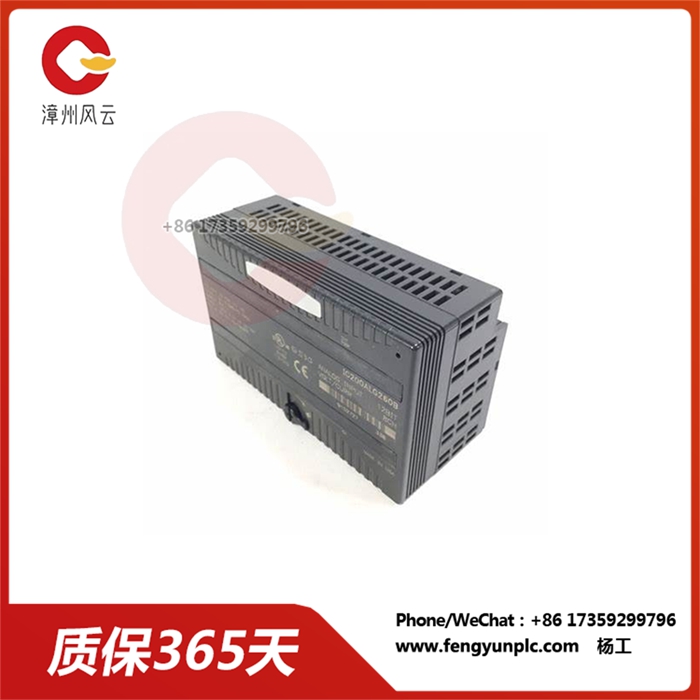 手机:17359299796
手机:17359299796— 产品中心 —
 全国免费客服电话 17359299796
全国免费客服电话 17359299796 邮箱:A3669372910@163.com
手机:17359299796
电话:17359299796
地址:福建省漳州市龙文区朝阳北路1号办公楼205室
IC200ALG260B 分析输入模块IC200ALG260B是 GE Fanuc(现为艾默生自动化解决方案的一部分)的 VersaMax 系列的模拟输入/输出
产品详情
IC200ALG260B 分析输入模块
IC200ALG260B是 GE Fanuc(现为艾默生自动化解决方案的一部分)的 VersaMax 系列的模拟输入/输出 (I/O) 模块。它设计用于工业自动化和控制系统,从现场设备获取模拟数据,并为控制执行器提供模拟输出信号。该模块具有 4 个隔离式模拟输入通道,每个通道能够接受 4-20 mA 电流信号或 0-10 VDC 电压信号。此外,它还提供 4 个模拟输出通道,每个通道能够产生 4-20 mA 电流信号或 0-10 VDC 电压信号。转换后的模拟数据被传输到PLC或控制器进行处理和控制,而模拟输出信号则用于控制执行器和其他设备。
主要特点:
4 个隔离模拟输入通道:支持 4 个隔离模拟输入通道,可同时监控多个现场设备。
电流/电压输入模式:接受 4-20 mA 电流信号和 0-10 VDC 电压信号,可灵活连接各种传感器和变送器。
16 位分辨率:提供 16 位分辨率,可实现高精度数据转换,确保模拟信号的精确表示。
信号滤波:集成信号滤波功能,可消除噪声和干扰,保证数据完整性。
4 个模拟输出通道:提供 4 个模拟输出通道,用于控制执行器和其他设备。
12 位分辨率:提供 12 位分辨率,可实现精确的模拟输出生成,确保对执行器的精确控制。
应用:
工业自动化系统:主要用于工业自动化系统,从监控各种过程参数(如温度、压力、流量和液位)的传感器获取模拟数据,并为控制执行器(如阀门、电机和加热器)提供模拟输出信号。
过程控制系统:用于过程控制系统,收集数据以实时监测和控制过程变量,确保一致的产品质量和高效运行,并提供模拟输出信号来调节过程参数。
制造自动化:集成到制造自动化系统中,从传感器收集数据,监测机器状况,如振动、速度和扭矩,并提供模拟输出信号来控制机器运行,从而实现预测性维护和性能优化。
环境监测系统:用于环境监测系统,获取环境参数数据,如空气质量、水质和噪音水平,并提供模拟输出信号来控制通风系统、泵和其他设备,确保环境保护和法规遵从性。
测试和测量系统:用于测试和测量系统,从模拟传感器收集数据,并提供模拟输出信号来控制测试设备,从而实现产品测试、研究和开发。
好处:
改进的过程控制:通过提供准确可靠的模拟数据和精确的模拟输出信号,有助于改善过程控制,从而实现对过程参数的精确监测和控制。
提高系统效率:通过基于模拟传感器的实时数据优化过程操作和执行器的精确控制,提高系统效率。
降低维护成本:通过实现基于传感器数据的预测性维护和对执行器的精确控制,防止意外故障和停机,从而最大限度地降低维护成本。
提高产品质量:通过准确的数据采集和精确的控制,确保一致的工艺参数和产品规格,有助于提高产品质量。

IC200ALG260B 分析输入模块
The IC200ALG260B is an analog input/output (I/O) module for the VersaMax family of GE Fanuc, now part of Emerson Automation Solutions. It is designed for use in industrial automation and control systems, taking analog data from field equipment and providing analog output signals for control actuators. The module has four isolated analog input channels, each capable of receiving 4-20 mA current signals or 0-10 VDC voltage signals. In addition, it offers four analog output channels, each capable of producing a 4-20 mA current signal or a 0-10 VDC voltage signal. The converted analog data is transferred to a PLC or controller for processing and control, while the analog output signals are used to control actuators and other devices.
Main features:
4 isolated analog input channels: Support 4 isolated analog input channels to monitor multiple field devices simultaneously.
Current/voltage input mode: Accepts 4-20 mA current signal and 0-10 VDC voltage signal, flexible connection of various sensors and transmitters.
16-bit resolution: Provides 16-bit resolution for high-precision data conversion, ensuring accurate representation of analog signals.
Signal filtering: Integrated signal filtering function can eliminate noise and interference to ensure data integrity.
4 analog output channels: 4 analog output channels are provided to control actuators and other devices.
12-bit resolution: Provides 12-bit resolution for accurate analog output generation, ensuring precise control of the actuator.
Applications:
Industrial automation systems: Mainly used in industrial automation systems, analog data is obtained from sensors that monitor various process parameters such as temperature, pressure, flow, and level, and analog output signals are provided for control actuators such as valves, motors, and heaters.
Process control systems: For process control systems that collect data to monitor and control process variables in real time, ensure consistent product quality and efficient operation, and provide analog output signals to regulate process parameters.
Manufacturing automation: Integrated into manufacturing automation systems, collect data from sensors, monitor machine conditions such as vibration, speed and torque, and provide analog output signals to control machine operation, enabling predictive maintenance and performance optimization.
Environmental monitoring systems: Used in environmental monitoring systems to capture data on environmental parameters, such as air quality, water quality and noise levels, and to provide analog output signals to control ventilation systems, pumps and other equipment to ensure environmental protection and regulatory compliance.
Test and measurement systems: For test and measurement systems, collect data from analog sensors and provide analog output signals to control test equipment, enabling product testing, research and development.
Benefits:
Improved process control: By providing accurate and reliable analog data and accurate analog output signals, it helps to improve process control, thus enabling accurate monitoring and control of process parameters.
Improve system efficiency: Improve system efficiency by optimizing process operation and precise control of actuators with real-time data based on analog sensors.
Reduce maintenance costs: Minimize maintenance costs by enabling predictive maintenance based on sensor data and precise control of actuators to prevent unplanned failures and downtime.
Improve product quality: Ensuring consistent process parameters and product specifications through accurate data collection and precise control helps to improve product quality.

相关推荐